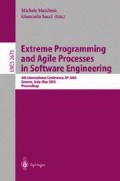Abstract
Pair Programming has been shown to increase communication and teamwork skills and to provide better code. The aim of this work is to show the efficacy of Pair Programming in transferring knowledge and skills over an environment where people met only occasionally. In a quasi experiment, we find that Pair Programming is effective in sharing knowledge among 15 students who met once a week for a half day, and did their internship individually or in couple for the remaining 4 half days.
Access this chapter
Tax calculation will be finalised at checkout
Purchases are for personal use only
Preview
Unable to display preview. Download preview PDF.
References
Kircher, M., Jain, P., Corsaro, A., Levine, D.: Distributed eXtreme Programming. Proceedings of XP2001 May (2001). Available at http://www.xp2001.org
Cockburn, A., Williams, L.: The Costs and Benefits of Pair Programming. In: Succi G., Marchesi M. (eds.): Extreme Programming Examined. Addison Wesley Professional (2001) 223–248
Williams, L., Kessler, R., Cunningham, W., Jeffries, R.: Strengthening the Case for Pair Programming. IEEE Software. 17 (2000) 19–25
Baheti, P., Williams, L., Gehringer, E., Stotts, D., Smith J.: Distributed Pair Programming Empirical Studies and Supporting Environments. Technical Report TR02-010 Dep. Computer Science Univ. of North Carolina at Chapel Hill 15 (2002)
Basili, V., Rombach, D.: The TAME Project: Towards Improvement-Oriented Software Environments. IEEE Trans. of Software Eng. 14(6) (1988) 758–773
Wohlin, C., Runeson, P., Höst, M., Ohlsson, M. C., Regnell, B, Wesslén A.: Experimentation in Software Engineering: An Introduction. Kluwer Academic Publishers, December (2000)
Succi, G., Marchesi, M., Pedrycz, W., Williams, L.: Preliminary Analysis of the Effects of Pair Programming on Job Satisfaction. Proceedings of XP2002 May 2002. Available at http://www.xp2002.org
Author information
Authors and Affiliations
Editor information
Editors and Affiliations
Rights and permissions
Copyright information
© 2003 Springer-Verlag Berlin Heidelberg
About this paper
Cite this paper
Janes, A., Russo, B., Zuliani, P., Succi, G. (2003). An Empirical Analysis on the Discontinuous Use of Pair Programming. In: Marchesi, M., Succi, G. (eds) Extreme Programming and Agile Processes in Software Engineering. XP 2003. Lecture Notes in Computer Science, vol 2675. Springer, Berlin, Heidelberg. https://doi.org/10.1007/3-540-44870-5_26
Download citation
DOI: https://doi.org/10.1007/3-540-44870-5_26
Published:
Publisher Name: Springer, Berlin, Heidelberg
Print ISBN: 978-3-540-40215-2
Online ISBN: 978-3-540-44870-9
eBook Packages: Springer Book Archive

